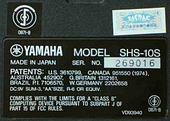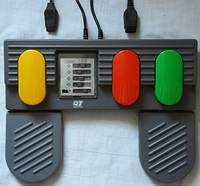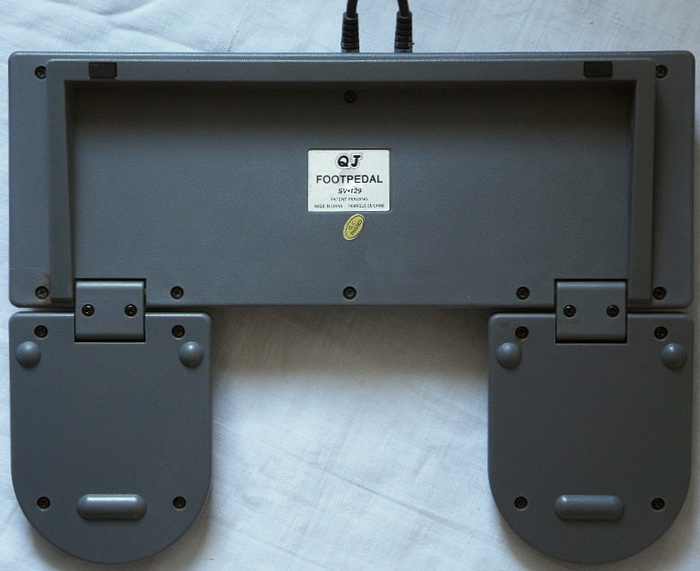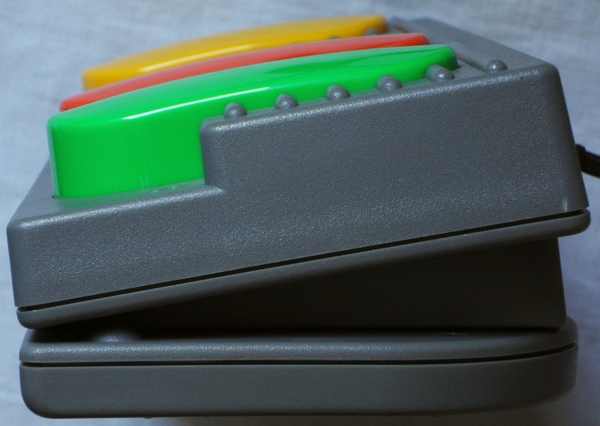|
The Yamaha PortaSound SHS-10 of 1987 (embossed case date) was one of the first portable FM keyboards with MIDI-out and complex orchestrated accompaniment section ("style bank" having 25 styles with each 3 fill-ins + ending). As a keytar you can hold it in a guitar manner to pose on stage, so SHS stands for the Japanese marketing name "Sholky" (shoulder keyboard).
But by the lack of key split the left keyboard half can not be assigned to the accompaniment section, thus accompaniment can not be played in realtime the normal way together with the main voice. Instead there is a strange "melody on A.B.C." mode, which plays monophonic main voice notes but recognizes standard chords and layers these with the chord or accompaniment voice. In an other mode only chords can be played (annoyingly refuses to play any non-chords - much like Yamaha PSS-390) and chords can be also recorded into a simple internal sequencer, which holds 3 sequences. The preset rhythms are made from classic, very electronic sounding FM percussion (like known from old PC games on the historical AdLib soundcards). Also the main voice sounds are made from simple 2 operator FM. Interesting is that the SHS-10 has a pitchbend wheel and portamento with both adjustable intensity.
This instrument was also released in a red and a black case version.
regard: On eBay people sometimes pay moon prices (200 US$ etc.) for the Yamaha SHS-10 those are very questionable. Despite this is a guitar-style keyboard with MIDI- out and pitchbend wheel, the keys are midsize and not velocity sensitive, the wheel has coarse resolution and the sounds are all very plain and simple 2 operator FM (like from old PC games on AdLib sound card) with thin FM drums. Also the accompaniment styles are mainly centered on country musics, jazz, 1950th rock 'n roll and the like; many sound over-orchestrated and they are not really a proper choice for playing pop or tekkno musics. So it is more a design object than a serious professional instrument. Seeing these crazy prices sometime paid for this rather simple sounding guitar keyboard, I regard it only a matter of time until people also decide to pay their ass off for the similar looking toy keyboard "RJP 896 Programmable Guitar Organ" ;-) (which has only 2 monophonic sounds and not even rhythm).
 |
 |
 |
The preset sounds are made from very simple programmed 2 operator FM (without sophisticated envelope tricks) and don't sound really realistic. E.g. the "piano" and acoustic guitar timbres have the typical FM plastic guitar appeal with dull and hollow bass range. "synthesizer" is a thin and gritty synth brass "meow" sound (with that the instrument comes up after power-on - no good choice). The "rock guitar" is rather a nice sitar sound. The "marimba" has a strange dull plastic knock during attack of low notes. The "whistle" resembles an high pitch ocarina and makes strange aliasing distortions at high notes when transposed up. Select "melody on A.B.C." mode to play the main voice monophonic. Nice the the portamento feature (like with Casio SK-1), which makes theremin- like glide tones with adjustable speed.
The accompaniment styles have each 3 fill-ins and ending, but they are mainly centered on country musics, jazz, 1950th rock 'n' roll and the like and many sound over- orchestrated and thus are not really versatile. Instead of a normal chord section on keyboard, this instrument has the strange "melody on A.B.C." mode, which plays monophonic notes with the main voice but recognizes fingered standard chords and plays these with the chord or accompaniment voice. Variants of it are the "auto bass" and "auto chord" mode, those play only bass or only chord instead of the full accompaniment. The "auto bass chord" mode plays only fingered standard chords (no melody voice) but also ignores anything beyond establishment chords, which is quite annoying. Also the "single finger chord" plays only accompaniment on the entire keyboard. With rhythm off, the instrument plays manual chords instead of accompaniment; its preset sound depends on the selected rhythm number.
 |
 |
 |
circuit bending detailsThe Yamaha SHS-10 employs fairly complex multi-chip hardware based on the CPU "Yamaha XD107B0, 31Y0D02P" and the simple FM sound IC YM2420. For I/O the CPU communicates with the additional gate array IC "XC894A0, A128 7A650" which handles the keyboard matrix, external ROM and 2KB SRAM.
The gate array IC "XC894A0, A128 7A650" (64 pin SMD) has one slanted corner, though within this text I refer the pin to the right of it as pin 1 and count pins anti-clockwise. However on the PCB is also an triangular (arrow?) mark pointing at a different pin and I have no schematics, thus I am not sure if the original pin numbering differs. keyboard matrixThe keyboard matrix is handled by the gate array, but the 5 output lines for the panel buttons come from the CPU. The keys are grouped by 6. In service mode unused matrix places in panel button section (out pins from CPU) toot at the same pitch like the 'demo' button. (I checked that these don't seem to be any fixed diode "model select" features.) Other unused places (using out pins from gate array) do nothing in service mode.As the only easteregg this hardware supports 17 lower note keys (49
total), but unfortunately I found no tricks to enable a key split chord
mode like in normal keyboards, which hints that the software was exactly
tailored for this model and not taken from a regular non-keytar instrument.
The input lines are active-low, i.e. react on GND. Any functions can
be triggered by a non- locking switch in series to a diode from one "in"
to one "out" pin.
At the PCB are 2 foil cables where most of the matrix pins can be accessed
easier. These are their pinouts (foil cables facing down, counting from
left to right).
add locking switches & pedal jackI wired each [a locking switch in series to a diode] parallel to the vibrato, portamento and sustain buttons and the 3 fill-in buttons to make them lock. Unfortunately by software reasons only 2 of these controls can be enabled simultaneously (likely because a matrix mess protection algorithm blocks further button presses in the originally diode- less keyboard matrix).I also wired a 9 pin Atari style joystick port through two "4071" logics ICs (each containing 4 OR gates) with the vibrato, portamento and sustain buttons to enable to play these functions through an Amiga racing game pedal unit (which contains 3 foot switches). The OR gates simulate a button press in the key matrix when one input (with 4.7 kOhm pullup- resistor against +5V) is pulled against GND by the joystick and the other input by the corresponding key matrix output. The OR gate output is connected with the corresponding key matrix input line through a diode to pull it against GND when low. The diode prevents short circuit when the gate output is high. The OR gates make it possible to demultiplex a keyboard matrix place (that connects an input with an output line to trigger a function) into a DC controllable switch input. With an active- high keyboard matrix you would need AND gates instead of OR gates.
FM synthesizer upgradeThe SHS-10 has only 25 built-in preset sounds; this is a description how to install a DIPshit mod to cheaply add some more. The FM sound IC YM2420 is very similar to YM2413. By soldering an 8x DIP switch into the cut traces to its data lines (pins 2, 3, 4, 5, 6, 7, 17, 18) it is possible to create many other strange sounds by opening one or more switches while selecting a sound and then closing them again. For safety I had additionally wired each a 2.2k resistor in series to reduce CPU burden.At the sound IC side solder from each data pins a 47k pullup resistor to a common point and wire it to the center pin of one toggle switch that switches it to either GND or +Vs (sound IC pins 1 or 16) to set the affected data lines either lo or hi when disabled by the DIP block. (Active data lines override the low current from the 47k resistor by the CPU signal..) This kind of modification works also with many other FM keyboards, for details see here about my Fujitone 6A.
The DIPshit synth can create many strange and interesting sound, including surprising variety of unheard percussion timbres those were never made available in normal FM keyboards. pinout YM2420The OPLL-2 "Yamaha YM2420" (18 pin DIL) is a 2-operator FM sound IC used in various Yamaha midsize keyboards. It is pin compatible with the documented OPLL Yamaha YM2413 and only differs in software behaviour. In a forum Synthhead mentioned that e.g. the note frequency table is upside-down (may be to complicate hardware piracy), but even the 15 internal preset sounds are the same. The YM2413B can do either 9 note polyphonic melodic timbres or 6 melody sounds + 5 rhythm sounds. The IC has 2 analogue outputs for melodic and percussion sounds. Typical for Yamaha, the internal 9 bit DAC outputs all channels as timeslices, i.e. the 9 polyphony channels are time-multiplexed analogue signals (an absent or mute channel stays zero) with high resistance sections in between. Mixed by a simple external capacitor, the benefit of this is that polyphony channels don't need additional DAC bits, hence with 9 simultaneous notes it roughly corresponds to 13 bit DAC resolution.This pinout is based on blurred Yamaha VSS-200 service manual
photos (pin names taken from there).
|
A bigger variant of this instrument was released as Yamaha SHS-200
(I own one); it has 49 midsize keys, each 49 preset sounds & rhythms
and stereo chorus. Most interesting is that it can be switched to dual-handed
play (i.e. separate chord section + effect buttons stay on). The case style
of the SHS-10 was imitated in the toy keyboards RJP 896 Programmable
Guitar Organ (only 2 monophonic sounds, pitchbend, vibrato, 10 demos,
no rhythm) and RJP - Dynamic
Keyboard MU-7986.
| removal of these screws voids warranty... | ||
 |
||
|
|